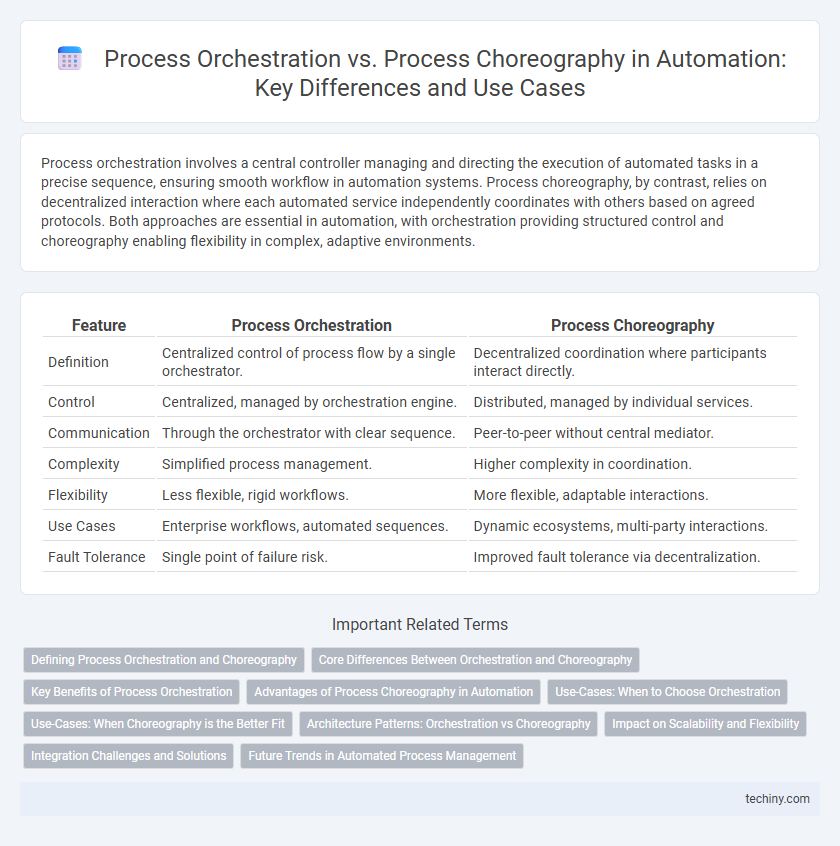Process orchestration involves a central controller managing and directing the execution of automated tasks in a precise sequence, ensuring smooth workflow in automation systems. Process choreography, by contrast, relies on decentralized interaction where each automated service independently coordinates with others based on agreed protocols. Both approaches are essential in automation, with orchestration providing structured control and choreography enabling flexibility in complex, adaptive environments.
Table of Comparison
| Feature | Process Orchestration | Process Choreography |
|---|---|---|
| Definition | Centralized control of process flow by a single orchestrator. | Decentralized coordination where participants interact directly. |
| Control | Centralized, managed by orchestration engine. | Distributed, managed by individual services. |
| Communication | Through the orchestrator with clear sequence. | Peer-to-peer without central mediator. |
| Complexity | Simplified process management. | Higher complexity in coordination. |
| Flexibility | Less flexible, rigid workflows. | More flexible, adaptable interactions. |
| Use Cases | Enterprise workflows, automated sequences. | Dynamic ecosystems, multi-party interactions. |
| Fault Tolerance | Single point of failure risk. | Improved fault tolerance via decentralization. |
Defining Process Orchestration and Choreography
Process orchestration centralizes control by coordinating and managing individual tasks within a workflow through a single orchestrator, ensuring a structured sequence of activities. Process choreography distributes control across multiple autonomous participants that interact through message exchanges, enabling a decentralized and collaborative execution of processes. Both approaches optimize automation but differ fundamentally in control mechanisms and workflow visibility.
Core Differences Between Orchestration and Choreography
Process orchestration centralizes control by managing and coordinating interactions between services through a single orchestrator, ensuring a streamlined, top-down execution flow. In contrast, process choreography decentralizes control, where each service communicates directly with others, enabling a more flexible and event-driven interaction model. The core difference lies in orchestration's explicit, centralized command structure versus choreography's implicit, distributed collaboration among autonomous components.
Key Benefits of Process Orchestration
Process orchestration centralizes control by managing and automating workflows through a single orchestrator, ensuring seamless coordination of complex tasks across multiple systems. It enhances efficiency by providing end-to-end visibility, real-time monitoring, and error handling, which reduces operational risks and accelerates process execution. This approach enables organizations to standardize processes, improve resource utilization, and achieve higher scalability compared to decentralized process choreography.
Advantages of Process Choreography in Automation
Process Choreography in automation allows decentralized control by enabling individual services to coordinate directly, enhancing system flexibility and scalability. This approach reduces bottlenecks and single points of failure common in Process Orchestration, leading to improved fault tolerance and adaptability in dynamic environments. Increased transparency in communication patterns among services facilitates easier maintenance and faster response to changes or disruptions.
Use-Cases: When to Choose Orchestration
Process orchestration is ideal for complex workflows requiring centralized control and coordination across multiple services, such as order processing or automated financial transactions. It ensures sequential execution and error handling, making it suitable for scenarios demanding strict compliance and audit trails. Organizations should choose orchestration when process visibility, control, and integration with legacy systems are critical for operational efficiency.
Use-Cases: When Choreography is the Better Fit
Process choreography is the better fit in decentralized automation scenarios where multiple independent services or systems need to interact without a central controller, such as in microservices architectures or event-driven environments. It excels in use-cases like supply chain management and IoT ecosystems, where agility, scalability, and loose coupling enable real-time responsiveness and autonomous decision-making. By enabling each participant to manage its own workflow and communicate through event exchanges, process choreography supports dynamic, distributed processes with high flexibility and reduced bottlenecks.
Architecture Patterns: Orchestration vs Choreography
Process orchestration relies on a centralized architecture where a single controller manages and coordinates all workflow activities, enabling streamlined process execution and improved error handling. In contrast, process choreography employs a decentralized architecture where individual services interact directly through event-driven communication, promoting flexibility and scalability across distributed systems. Both patterns optimize automation by aligning architectural design with organizational needs: orchestration suits tightly controlled environments, while choreography excels in dynamic, loosely coupled ecosystems.
Impact on Scalability and Flexibility
Process orchestration centralizes control by managing workflows through a single orchestrator, enhancing scalability by simplifying monitoring and resource allocation, but potentially limiting flexibility due to rigid process dependencies. Process choreography distributes control among individual services that interact directly, offering greater flexibility to adapt and evolve processes independently, which supports dynamic scaling in complex, decentralized environments. Organizations seeking scalable automation solutions must balance orchestration's streamlined management with choreography's adaptability to optimize performance and responsiveness.
Integration Challenges and Solutions
Process Orchestration centralizes control by managing workflows through a single coordinator, simplifying integration but risking bottlenecks and single points of failure. Process Choreography distributes control among autonomous services, enhancing flexibility and scalability but complicating integration due to the need for robust communication protocols and real-time event handling. Solutions to integration challenges include adopting standardized APIs, utilizing event-driven architectures, and implementing middleware platforms that support both orchestration and choreography paradigms for seamless interoperability.
Future Trends in Automated Process Management
Process orchestration centralizes control by managing workflows through a single automated engine, enhancing efficiency in complex business processes. In contrast, process choreography emphasizes decentralized interaction among multiple services, enabling adaptable and scalable automation frameworks. Future trends in automated process management highlight the integration of AI-driven analytics and real-time decision-making to optimize both orchestration and choreography for dynamic, interconnected enterprise environments.
Process Orchestration vs Process Choreography Infographic

 techiny.com
techiny.com